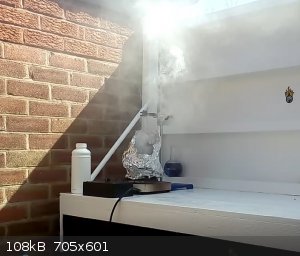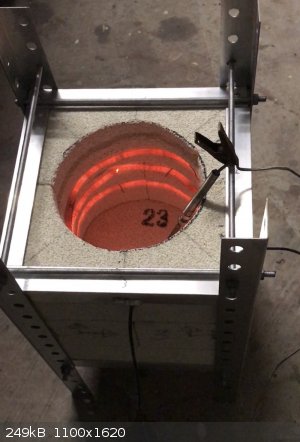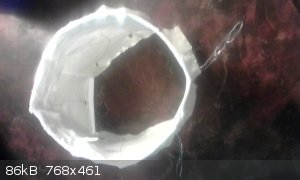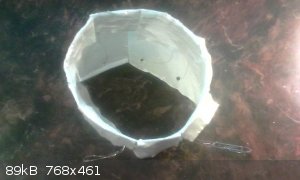Funkerman23
Hazard to Others
  
Posts: 416
Registered: 4-1-2012
Location: Dixie
Member Is Offline
Mood: No Mood
|
|
Sulfuric acid distillation: heating routes?
Hello!
Most of us have seen Nurdrage's video on distilling it, and there was a thread here on quartz distilling flasks that could do this with the right
flame.
What I want to know is; for those of you who have distilled Sulfuric acid to its azeotrope, what was your preferred heating method?
Did a sand bath& burner work well or would a High temp mantle from
glas-col be better? Is the Quartz really needed or did you feel safe with Borosilicate?
I am asking for more of a consensus and opinions thread than anything else.
Thanks, in anycase and good day.
" the Modern Chemist is inundated with literature"-Unknown
|
|
|
Sulaiman
International Hazard
    
Posts: 3558
Registered: 8-2-2015
Location: 3rd rock from the sun
Member Is Offline
|
|
I have not distilled sulfuric acid yet but I have concentrated it by boiling, almost the same as a simple distillation.
I did it in a cheap borosilicate beaker ... that developed three tiny radial cracks around the bottom where the base meets the walls,
I think that it was caused by uneven heating on my hotplate,
so I suggest a sand or hot air bath or rbf/mantle combination.
You need to take care that no cold condensate drips onto hot glass
so everything from the flask to the still head should be thermally insulated, I believe.
I have not even titrated the (presumed) concentrated acid yet so take my words with caution 
The drain cleaner as purchased boiled at c325 oC and I stopped the boiling when the b.p. reached 331 o due to choking clouds of
acid vapour

I suspect that obtaining the azeotropic concentration by simple distillation will be difficult to achieve,
and fine fractional distillation would be difficult to do due to heat losses,
96 - 97 % seems straight forward but I bet that 98% is not easy.
P.S. use an air condenser rather than a Leibig etc. as I believe that the temperature difference between the inner and outer walls causes enough
differential thermal expansion along the tubing length that it may crack the glass, although YouTube videos often show such an arrangement used.
[Edited on 3-7-2017 by Sulaiman]
CAUTION : Hobby Chemist, not Professional or even Amateur
|
|
|
JJay
International Hazard
    
Posts: 3440
Registered: 15-10-2015
Member Is Offline
|
|
There are several videos on YouTube of people distilling sulfuric acid in borosilicate glass with a heating mantle. I did see one video of someone
doing it in borosilicate glass over direct flame, but that's probably not a good idea. You can heat quartz with a direct propane flame (like a Bunsen
burner or a camping stove), but direct heating can be dangerous with borosilicate glass, which has a much higher coefficient of expansion and a
maximum working temperature of around 550 C. I don't see why sulfuric acid couldn't be distilled in borosilicate over a wire gauze, although care
should be taken to avoid hot spots and overheating (and obviously this should be performed only outside or in a fume hood).
The major drawback of sand baths is the amount time it takes to heat them up safely, not to mention the relatively low rate of heat transfer; blasting
one with maximum heat from the start is likely to break a flask. I think mixing in some copper or iron pieces might greatly improve heat transfer.
It goes without saying that distilling sulfuric acid is very dangerous. I think the risk is lower in quartz, and it's much easier to just distill over
a flame if you're doing your distillation out of doors. But it can be done in borosilicate glass with a heating mantle.
[Edited on 3-7-2017 by JJay]
|
|
|
LD5050
Hazard to Others
  
Posts: 182
Registered: 16-1-2017
Member Is Offline
Mood: No Mood
|
|
I used to concentrate drain cleaner all the time by simple distillation with cheap eBay borosilicate glass. For a heating mantle I would make one
frome the heating wire from an old stove I had taken apart. I would mold plaster of Paris around a RBF and then wrap the wire around the soft wet
plaster and then I would dry it in the oven and connect it up to a power source and it would work great. I have distilled H2SO4 around 5-10 times now
without ever any issue other than cracking one of my condensors because I made the stupid mistake of running cold water through it while distilling
the H2SO4.
I was thinking tho what about distilling it under vacuum? It should reduce the bp considerably but idk it seems like a recipe for disaster if the RBF
ever imploded.
My suggestion would be to find a good enough heat source take a cheap RBF and distill outside incase of equipment failure. As long as you are at a
safe distance if anything ever happened you should be ok and the only damage would be a broken flask.
|
|
|
JJay
International Hazard
    
Posts: 3440
Registered: 15-10-2015
Member Is Offline
|
|
I guess I should mention that I'm planning on building a furnace for heating my crucibles and small flasks, and it might be used for sulfuric acid. I
considered constructing a heating mantle, but I think it's easier to build a furnace.... I'm going to make a mica cylinder that will with a small gap
wrap around a 500 mL flask. I'll coil a nichrome heating element around the cylinder, regulating power by a triac dimmer (could additionally use a
temperature probe and an Arduino, but I don't think I'll need anything like that right away). I still haven't decided exactly how I'm going to
insulate it; the obvious options are rockwool and refractory brick.
The maximum working temperature will be only around 800 C, but that should be sufficient for most things and is certainly hot enough to distill
sulfuric acid. A quartz or fired porcelain cylinder would be able to attain even higher temperatures.
|
|
|
LD5050
Hazard to Others
  
Posts: 182
Registered: 16-1-2017
Member Is Offline
Mood: No Mood
|
|
Jay I'm curious about this furnace you are talking about. How do you figure it would be easier to build than a heating mantle? I'm not questioning you
I'm just asking because maybe I would be interested in building one myself. Do you have any reference pics I could look at to see what you mean? Also
is this something that could be used with borosilicate?
|
|
|
JJay
International Hazard
    
Posts: 3440
Registered: 15-10-2015
Member Is Offline
|
|
I'm going to be posting pictures of it after I build it... I already bought most of the materials I need for it, and they are sitting in a storage
locker across town. The rest I can get at a home improvement or specialty insulation store. I think the design could be used with borosilicate as long
as care is taken not to let it get too hot. I selected this design mainly because I have tried building heating mantles, and I always had a terrible
time wrapping the wire around the base of the flask.
I'm planning on using the furnace to dehydrate sodium bisulfate to sodium pyrosulfate and then crack it to produce oleum. But I think it would work
fine for distilling sulfuric acid.
The main problem with vacuum distilling sulfuric acid would be getting sulfuric acid vapor in your vacuum pump oil; you'll definitely want to protect
your pump if you try it.
|
|
|
Dlavroht
Harmless

Posts: 1
Registered: 12-7-2017
Member Is Offline
Mood: No Mood
|
|
Quote: Originally posted by LD5050  | | I have distilled H2SO4 around 5-10 times now without ever any issue other than cracking one of my condensors because I made the stupid mistake of
running cold water through it while distilling the H2SO4. |
Can you explain a little more about how you
cracked your condenser? I thought the whole point of one was to bring gases down to a liquid state with a colder substance, so how could they crack by
using cold water? What was it made out of? I'm asking because I plan on making a distiller for H2SO4 soon, and I don't want to make mistakes that
other people have made.
[Edited on 13-7-2017 by Dlavroht]
|
|
|
ave369
Eastern European Lady of Mad Science
   
Posts: 596
Registered: 8-7-2015
Location: No Location
Member Is Offline
Mood: No Mood
|
|
Borosilicate round-bottom flask covered in asbestos cord to prevent refluxing on walls, camping gas heater and a wide berth while the apparatus is on:
this is my choice. Usually, a flask cracks after two to four such distillations, but it does not suddenly crack while the flame is on and burst acid
everywhere: rather, the apparatus finishes its work, cools, I disassemble it and find a tiny crack in the flask.
Smells like ammonia....
|
|
|
NEMO-Chemistry
International Hazard
    
Posts: 1559
Registered: 29-5-2016
Location: UK
Member Is Offline
Mood: No Mood
|
|
I used a pyrex glass cooking pan filled with some sand and stuck a normal round bottomed flask in that. i used 2 liebeg (200mm) condensers joined
together and no water for cooling.
Bum twitched all the way through it! That was on a large gas camping hob.
part of me thinks maybe a vacuum to lower the temp would help, but then you have the whole vac risk to worry about.........
[Edited on 14-7-2017 by NEMO-Chemistry]
|
|
|
NeonPulse
Hazard to Others
  
Posts: 417
Registered: 29-6-2013
Location: The other end of the internet.
Member Is Offline
Mood: Isolated from Reality! For Real this time....
|
|
Quote: Originally posted by LD5050  | | Jay I'm curious about this furnace you are talking about. How do you figure it would be easier to build than a heating mantle? I'm not questioning you
I'm just asking because maybe I would be interested in building one myself. Do you have any reference pics I could look at to see what you mean? Also
is this something that could be used with borosilicate? |
Here's one similar which I had just finished building. The thought never crossed my mind that I could distill sulfuric with it..... I do have one of
them replacement mantle sleeves which I want to dope up with hotter wire which will do it.
 
|
|
|
JJay
International Hazard
    
Posts: 3440
Registered: 15-10-2015
Member Is Offline
|
|
That furnace looks awesome! I started my first attempt at one by wrapping nichrome around a mica core, but mine isn't going to look as nice and I
don't think it will be very durable. I am planning on putting rockwool around it, but I definitely like your approach. What did you use to fasten
your heating element to the sides of the furnace?
 
I'm not too sure about its application in this furnace, but I do think that the mica foil I bought rolls up into nice tubes, so I think it could be
used to make a very cheap and simple tube furnace that can reach 800 C. Of course, that doesn't help much for sulfuric acid....
|
|
|
tsathoggua1
Hazard to Others
  
Posts: 335
Registered: 8-1-2017
Location: Beyond the pale
Member Is Offline
Mood: Phosphorescent
|
|
I'm not surprised your posterior was twitching, situated on a propane burner that
would make most people jump. that
would make most people jump.
|
|
|
NeonPulse
Hazard to Others
  
Posts: 417
Registered: 29-6-2013
Location: The other end of the internet.
Member Is Offline
Mood: Isolated from Reality! For Real this time....
|
|
I cut a groove in the firebricks for the element and used small bits of 1mm kanthal wire bent into little staples. They seem to have worked ok but I'm
yet to run this furnace to its potential. I still want to better insulate the outside of the firebricks with some ceramic kaowool. After running it as
a test at 430c for a half hour it was quite warm where the thinnest sides of brick are. I have since sealed up the joins with stove putty and have cut
the sections of kaowool ready and it will be sandwiched between ply and aluminium. Any heat felt is a loss in efficiency. I hope to push it to
900-1000c this is within the elements limits so it should be possible.
|
|
|
JJay
International Hazard
    
Posts: 3440
Registered: 15-10-2015
Member Is Offline
|
|
Nice... I like your design a lot. I will probably give something like that a try after I destroy my mica furnace.
|
|
|
Fyndium
International Hazard
    
Posts: 1192
Registered: 12-7-2020
Location: Not in USA
Member Is Offline
|
|
I was planning on distilling sulfuric acid under aspirator vacuum. At maximum theoretic aspirator vacuum of 32mbar it should take 337C BP down to 161C
which is well achievable, even with some liquid heating bath. I have 1L 3-neck flask which I usually use for vacuum distillations and I was gonna use
my ordinary setup to bleed air through capillary to eliminate bumping.
Just in case of implosion I was gonna build a temporary blast shield around the still from plywood and glass. It doesn't have to be resistant to
corrosion, but to stop the splashes and fragments and give time to spray Na2CO3 solution or just plain water with hose to it. This is carried in a
technical workspace where there is good drainage so pretty crude methods could be used in case necessary. I would never do it indoors or living
quarters, though.
|
|
|
Fyndium
International Hazard
    
Posts: 1192
Registered: 12-7-2020
Location: Not in USA
Member Is Offline
|
|
Ok, I attempted to distill sulfuric acid. I used avocado oil up to 220C with some smoking, but the acid didn't want to distill. I did not have probe
in the flask, only in the bath and the still head. Water boiled at 26C for control. I used bleeder for zero bumping. Does the acid have different
vapor pressure than water, aka does normal pressure boiling point calculation give how accurate temps for other substances than water?
|
|
|
macckone
International Hazard
    
Posts: 2159
Registered: 1-3-2013
Location: Over a mile high
Member Is Offline
Mood: Electrical
|
|
sulfuric acid is hard to distill.
It also has hydrates that impact the boiling point.
My guess is you had insufficient vacuum for the temperature of the acid.
|
|
|
clearly_not_atara
International Hazard
    
Posts: 2692
Registered: 3-11-2013
Member Is Offline
Mood: Big
|
|
If you heated the oil bath to 220 C and it was smoking, are you sure you left it hot long enough? Sounds like you would have stopped that pretty
quickly. But you need to let the flask sit in the oil bath for a while to come to temperature.
Also, while some Internet sources give the smoke point of avocado oil as 270 C, the actual smoke point of any sample of oil will depend highly on how
purified it is. Avocado oil has an excellent flavor and often isn't fully refined, reducing the smoke point dramatically.
But you can buy soybean oil or safflower oil that is specifically prepared for high-heat cooking, which will have a higher smoke point. It doesn't
taste good, but it should do a great job of distilling sulfuric acid :p
[Edited on 04-20-1969 by clearly_not_atara]
|
|
|
monolithic
Hazard to Others
  
Posts: 435
Registered: 5-3-2018
Member Is Offline
Mood: No Mood
|
|
Quote: Originally posted by Fyndium  | | Ok, I attempted to distill sulfuric acid. I used avocado oil up to 220C with some smoking, but the acid didn't want to distill. I did not have probe
in the flask, only in the bath and the still head. Water boiled at 26C for control. I used bleeder for zero bumping. Does the acid have different
vapor pressure than water, aka does normal pressure boiling point calculation give how accurate temps for other substances than water?
|
Boiling water at 26 C means a vacuum of about 60 torr which means sulfuric acid wouldn't boil until about 236 C with this same vacuum applied. Common
rule, at least for rotovaps, is that bath temperatures should be about 20 degrees higher than your boiling point. Your oil bath wasn't hot enough --
it would have to be around 256 C.
|
|
|
Fyndium
International Hazard
    
Posts: 1192
Registered: 12-7-2020
Location: Not in USA
Member Is Offline
|
|
What calculator/table do you use to determine boiling point? I got mine from here:
http://www.trimen.pl/witek/calculators/wrzenie.html
And I'm not sure if it's correct. It states that water should boil at 26C in 32mbar. 60 torr is about 80mbar?
I came to a conclusion that my pump was not quite to it's abilities because some of the water vaporized and ended up in the oil, making it a milky
emulsion, hence, the vapor pressure comes down due to water. No worries, I disassembled and cleaned the pump and changed the oil immediately after the
concentration process. I initially ran the aspirator, but it only brought the water bp down to 34-36C.
I need to improve it a bit by adding a graham condenser after the primary dimroth type condenser cooled with pumped air and ambient air by
coil&outer wall, and immerse the condensate flask in a cryogenic bath in order to keep the water from evaporating into the pump. A cold trap had
little help, it filled with condensed water multiple times.
I'm also aware of the temperature gradient, and I suspected it to be the reason alongside the insufficient vacuum.
For the matter, I might actually consider just distilling the acid via the Cody's lab way. Chinesium 1L flasks cost 5-10$ a piece so I can blast one
with propane flame and if it happens to crack, it's not a biggie. The times prior my baths I exclusively used bare flames to heat everything, which
would not be ideal, but the torture I exerted to the various glasses indicates that the statistical risk of cracking glassware seems to be lower than
presumed, warranting a controlled risk taking to cut a lot of extra work and possibly costs too(a heating mantle).
[Edited on 15-9-2020 by Fyndium]
[Edited on 15-9-2020 by Fyndium]
|
|
|
monolithic
Hazard to Others
  
Posts: 435
Registered: 5-3-2018
Member Is Offline
Mood: No Mood
|
|
Quote: Originally posted by Fyndium  | What calculator/table do you use to determine boiling point? I got mine from here:
http://www.trimen.pl/witek/calculators/wrzenie.html
And I'm not sure if it's correct. It states that water should boil at 26C in 32mbar. 60 torr is about 80mbar?
I came to a conclusion that my pump was not quite to it's abilities because some of the water vaporized and ended up in the oil, making it a milky
emulsion, hence, the vapor pressure comes down due to water. No worries, I disassembled and cleaned the pump and changed the oil immediately after the
concentration process. I initially ran the aspirator, but it only brought the water bp down to 34-36C.
I need to improve it a bit by adding a graham condenser after the primary dimroth type condenser cooled with pumped air and ambient air by
coil&outer wall, and immerse the condensate flask in a cryogenic bath in order to keep the water from evaporating into the pump. A cold trap had
little help, it filled with condensed water multiple times.
I'm also aware of the temperature gradient, and I suspected it to be the reason alongside the insufficient vacuum.
For the matter, I might actually consider just distilling the acid via the Cody's lab way. Chinesium 1L flasks cost 5-10$ a piece so I can blast one
with propane flame and if it happens to crack, it's not a biggie. The times prior my baths I exclusively used bare flames to heat everything, which
would not be ideal, but the torture I exerted to the various glasses indicates that the statistical risk of cracking glassware seems to be lower than
presumed, warranting a controlled risk taking to cut a lot of extra work and possibly costs too(a heating mantle).
[Edited on 15-9-2020 by Fyndium]
[Edited on 15-9-2020 by Fyndium] |
I use this one. https://www.sigmaaldrich.com/chemistry/solvents/learning-cen... In reality it's just an estimate. If you weren't seeing boiling then you weren't
pulling a hard enough vacuum. If that's as good as your vacuum pump can do, then you have to get it to a higher temperature until it begins to
distill.
|
|
|
Fyndium
International Hazard
    
Posts: 1192
Registered: 12-7-2020
Location: Not in USA
Member Is Offline
|
|
Nice, it gives 8C as water BP at 32mbar. The .pl site gives 26C.
Since (afaik) it is cheapest way to determine the vacuum by testing at which temp water boils, it would be nice to know the actual, accurate boiling
temp of water and what possible factors would affect it.
Engineeringtoolbox gives bp 25.7C, which is where .pl probably rounds it since it shows only full digits.
Sigma chart begins to differ at higher temps. 336C will turn into 208C from Sigma and 160C from .pl site. The estimate from reality probably doesn't
differ more than few deg C, and reaching 208C temp should be no issue.
Vacuum pump, afaik, can generate only as much vacuum as the vapor pressure of it's oil is, and if it is contaminated by (hot) water, it supposedly
affects the maximum vacuum reachable. Like said, I gotta test it out with new, clean oil and new setup to see if it's the actual mechanical limit. I'm
highly disappointed though, since the pump is rated at 5Pa vacuum, but most likely this has more than one or two digits of deviation because 100€
Chinesium rotary vane pump can be basically whatever that looks like a pump.
|
|
|